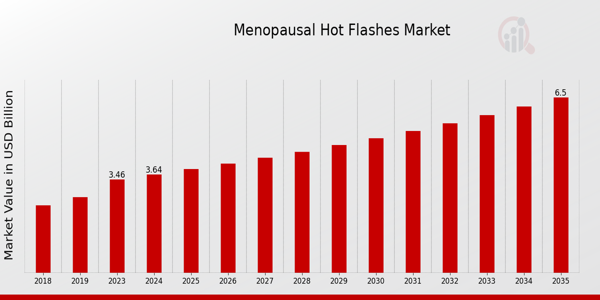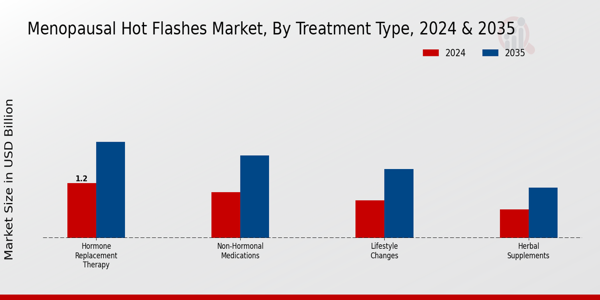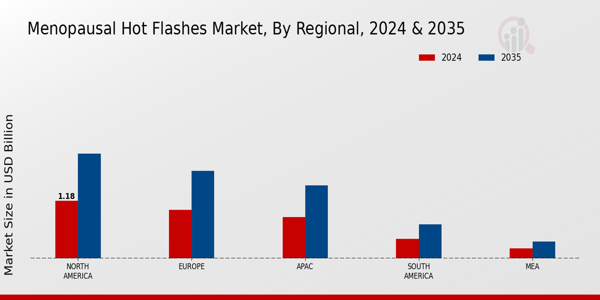Menopausal Hot Flashes Market Overview
As per MRFR analysis, the Menopausal Hot Flashes Market Size was estimated at 3.46 (USD Billion) in 2023. The Menopausal Hot Flashes Market Industry is expected to grow from 3.64(USD Billion) in 2024 to 6.5 (USD Billion) by 2035. The Menopausal Hot Flashes Market CAGR (growth rate) is expected to be around 5.4% during the forecast period (2025 - 2035)
Key Menopausal Hot Flashes Market Trends Highlighted
The is primarily driven by the rising awareness of menopause-related health issues among women. Increased access to healthcare information and advancements in medical solutions have led to a greater demand for effective treatments. The growing population of older women, particularly in developed countries, also contributes to the market expansion as more women seek relief from menopausal symptoms. Furthermore, the increasing inclination towards natural and hormone-free therapies reflects a shift in women's health strategies and preferences. There are numerous opportunities to be explored in the menopausal hot flashes segment, particularly in the development of innovative therapies and products that cater to various preferences.
Concentration on research and development encourages the formulation of novel treatments such as plant medicines and other holistic measures. Also, there is a need to improve the advertising of available medications through greater cooperation between medical practitioners and pharmaceutical companies. There are multi-dimensional opportunities to penetrate new horizons where menopausal education and treatment are lacking, but the demand is high. Current observations show an inclination towards all-round management of menopausal symptoms. This trend looks at incorporating diet, exercise, mental well-being, and other non-medical strategies with conventional medicine.
Increasing online platforms for education and support are also becoming essential tools for women experiencing menopausal symptoms. The emphasis is shifting from solely medication to a more rounded approach that considers physical, emotional, and social factors, providing a supportive ecosystem for women's health. All these factors combined suggest a dynamic and evolving landscape in the , leading to ongoing growth and development. 
Source: Primary Research, Secondary Research, MRFR Database and Analyst Review
Menopausal Hot Flashes Market Drivers
Increasing Awareness of Menopausal Symptoms
The growing awareness of menopausal symptoms, particularly hot flashes, among women of menopausal age is significantly driving the Industry. As more information becomes available about the effects of menopause and the available treatment options, women are becoming more proactive in seeking solutions for managing their symptoms. With greater access to information through various media channels, health professionals, and community resources, women are more informed about the health implications of menopausal symptoms like hot flashes.This shift in perception is fostering a greater willingness among the target population to explore treatments, which in turn is propelling market growth.
Additionally, increased patient education initiatives from healthcare providers are contributing to higher awareness levels, encouraging women to take action regarding their health. As the Industry continues to evolve, it is essential for stakeholders to recognize this trend and support initiatives that promote awareness and education around menopause, ensuring women understand that effective management options are available to alleviate their symptoms.The growing focus on women's health and bridging the knowledge gap correlates with the projected growth of the market as suppliers respond to this rising demand for effective treatment options for menopausal hot flashes. R
ising Prevalence of Menopausal Women The global population of menopausal women is on the rise, which is a significant driver for the Industry. As life expectancy increases and more women enter menopause, the demand for solutions that address menopausal symptoms, particularly hot flashes, grows concurrently. This demographic shift presents a substantial market opportunity as additional services and products become necessary to cater to the needs of these women.Furthermore, recognizing the increasing prevalence of menopause within aging populations, companies are focusing their efforts on developing treatments that specifically target hot flashes and other related symptoms, ensuring they meet the unique requirements of this demographic group.
Advancements in Treatment Options The ongoing advancements in treatment options for managing menopausal hot flashes are crucial for the Industry. Innovations in pharmacological therapies, including hormone replacement therapy (HRT) and non-hormonal alternatives, are expanding the choices available to women experiencing hot flashes. Continuous research and development efforts are also focused on creating more effective, safer, and user-friendly products that cater to varying preferences and health conditions.
As healthcare providers discover and recommend new treatment modalities, women are empowered by the possibility of finding effective relief from their symptoms, driving growth in the market. Furthermore, the development of personalized medicine and targeted therapies is gaining attention, as these approaches promise to enhance treatment efficacy and safety, satisfying the unique needs of women as they navigate menopause.
Menopausal Hot Flashes Market Segment Insights
Menopausal Hot Flashes Market Treatment Type Insights
The is experiencing a notable evolution, particularly in the Treatment Type segment, which includes Hormone Replacement Therapy, Non-Hormonal Medications, Lifestyle Changes, and Herbal Supplements. By 2024, the overall market is projected to reach a valuation of 3.64 USD Billion, with Treatment Type being a significant contributor to this growth. Among these treatment modalities, Hormone Replacement Therapy is anticipated to show strong performance, valued at 1.2 USD Billion in 2024 and increasing to 2.1 USD Billion by 2035. This treatment type dominates the market largely due to its effectiveness in alleviating menopausal symptoms and improving the quality of life for many women, making it a crucial option for healthcare providers.
Non-Hormonal Medications also play a critical role, with a value of 1.0 USD Billion in 2024, projected to rise to 1.8 USD Billion by 2035. The growing preference for alternatives to hormone therapy, driven by concerns over potential side effects, contributes to the market's expansion in this area. As a result, Non-Hormonal Medications are becoming increasingly significant within the , offering women safer, non-invasive options for managing their symptoms.Lifestyle Changes, valued at 0.82 USD Billion in 2024 and expected to grow to 1.5 USD Billion by 2035, represent another important treatment avenue. Many are incorporating holistic approaches like diet modifications and exercise into their management plans, focusing on overall health and well-being during menopause.
This segment indicates a shift in consumer behavior towards more sustainable and self-directed solutions, reflecting an increasing awareness of the importance of lifestyle in health outcomes.Lastly, Herbal Supplements, with a value of 0.62 USD Billion in 2024 and projected to reach 1.1 USD Billion by 2035, are gaining traction among women seeking natural remedies for hot flashes. The growing interest in alternative and complementary medicine is driving the popularity of botanical options, appealing to those who prefer to minimize pharmaceutical interventions. Although currently the smallest segment in terms of market share, its steady growth indicates a rising acceptance of herbal approaches as viable and beneficial in managing menopausal symptoms.
Overall, the Treatment Type segment of the is expected to see diverse growth, driven by a mix of traditional and alternative therapies that cater to the evolving needs of women during menopause. The significant positions held by Hormone Replacement Therapy and Non-Hormonal Medications illustrate the demand for effective solutions, while the rising interest in Lifestyle Changes and Herbal Supplements points to a broader trend toward personalized and natural treatment options. This segment showcases dynamic responses to varying preferences within the market, reflecting changing attitudes towards health care in the menopausal stage.

Source: Primary Research, Secondary Research, MRFR Database and Analyst Review
Menopausal Hot Flashes Market Distribution Channel Insights
The Distribution Channel segment of the plays a pivotal role in ensuring the availability and accessibility of products tailored for managing menopausal symptoms. In 2024, the revenue is expected to reach 3.64 billion USD, highlighting the importance of effective distribution channels in driving growth. Among the various channels, Retail Pharmacy is notably significant, offering convenience and immediate access to consumers. Online Pharmacy continues to gain traction, attributed to the growing trend of e-commerce and the preference for discreet purchasing options.Hospital Pharmacy serves as a crucial point of care, where healthcare professionals can recommend and dispense treatments, ensuring that patients receive appropriate therapies post-evaluation.
Supermarkets, meanwhile, enhance the visibility and accessibility of menopausal products, catering to a varied consumer base that seeks all-in-one shopping experiences. This diverse array of distribution channels not only meets consumer demands but also contributes to the overall statistics, driving awareness and adoption of treatment options among women experiencing menopausal hot flashes.
Menopausal Hot Flashes Market End User Insights
The ,expected to reach a valuation of 3.64 USD Billion in 2024, showcases significant segmentation in its End User category, including Hospitals, Clinics, and Homecare Settings. Hospitals play a crucial role with their extensive facilities and access to advanced treatment options, making them a central point for managing menopausal hot flashes. Clinics usually cater to a more localized patient base, providing tailored care and treatments, reflecting growing preferences for specialized services. Meanwhile, Homecare Settings are gaining prominence as more patients seek convenient and personalized management options, underscoring a shift towards at-home care solutions.The market is witnessing trends driven by increasing awareness of women's health, evolving patient preferences, and advancements in treatment technologies.
However, it also faces challenges such as resistance to treatment and socioeconomic disparities affecting access to care, which impact overall participation in these settings. Opportunities exist in expanding healthcare infrastructure and innovative treatment offerings, which can enhance the patient experience and drive overall growth in the revenue. As the market evolves, the segmentation within End Users will likely influence the dynamics of patient care and treatment approaches.
Menopausal Hot Flashes Market Formulation Insights
The is set to reach a valuation of 3.64 USD Billion by 2024, reflecting a steady growth trajectory within the formulation segment. This segment encompasses various types of products, including tablets, capsules, topical treatments, and injections, each playing a vital role in addressing menopausal symptoms. Tablets and capsules often dominate market preferences due to their convenience and ease of use, making them a significant aspect of treatment strategies for many women. Topical treatments provide targeted relief and are gaining popularity for their localized effects, catering effectively to those seeking immediate comfort.
Additionally, injections represent an advanced option in the market, offering prolonged effects and are increasingly being recognized for their efficacy. The diversity in the formulation types indicates the market's adaptability to meet varying patient needs and preferences. The projected growth is driven by increasing awareness of menopausal health issues, alongside advocacy for women's health, creating numerous opportunities for product innovation and development in the .
Menopausal Hot Flashes Market Regional Insights
The segmented by region, has shown considerable growth and diverse dynamics across its various areas. In 2024, North America is valued at 1.18 USD Billion, leading the market with a majority holding, attributed to high awareness and robust healthcare infrastructure. Europe follows closely with a market valuation of 1.0 USD Billion, driven by a significant aging population and increasing demand for effective treatments. The APAC region is also notable, with a market value of 0.85 USD Billion in 2024, reflecting the rising healthcare spending and awareness among women regarding menopausal symptoms.
South America and MEA are smaller segments, valued at 0.4 USD Billion and 0.21 USD Billion, respectively, in 2024. These regions face unique challenges but present significant opportunities for growth due to improving healthcare conditions and rising acceptance of menopausal health products. Overall insights indicate a continually expanding market, with North America and Europe dominating due to advanced healthcare systems and higher disposable incomes, while APAC is emerging as a significant growth area, promising enhanced market dynamics in the coming years.

Source: Primary Research, Secondary Research, MRFR Database and Analyst Review
Menopausal Hot Flashes Market Key Players and Competitive Insights
The is characterized by a rapidly evolving landscape driven by increased awareness and demand for effective treatment options for menopausal symptoms. As the global population ages and more women enter the menopausal phase, the need for innovative and reliable solutions to manage hot flashes is becoming more pronounced. The competitive insights in this market reveal a growing number of pharmaceutical companies focusing on the development of both hormonal and non-hormonal therapies to cater to diverse patient preferences.
Companies are increasingly investing in research and development to enhance the efficacy and safety profiles of their products while also exploring strategic partnerships and collaborations to expand their market presence. This competitive environment has led to a range of treatment options becoming available to consumers, thereby influencing market dynamics and shaping the overall consumer experience.Mylan has established a robust presence in the , leveraging its strengths in product innovation and accessibility. The company is known for offering a variety of treatment options that address the needs of women experiencing menopausal symptoms, which includes proprietary formulations that are competitive within the market.
Mylan's commitment to quality and patient-centric approaches ensures that its products are widely recognized and trusted by healthcare professionals and patients alike. Moreover, Mylan's extensive distribution networks enable the company to reach a broad demographic, ensuring that its solutions for hot flashes are accessible to a diverse array of women. This combination of product diversity, quality assurance, and significant market penetration positions Mylan favorably within the competitive landscape of the menopausal hot flashes market.Amgen has also carved a niche for itself within the , focusing on the development and delivery of innovative therapies aimed at alleviating menopausal symptoms.
The company's expertise in biotechnology allows it to integrate advanced scientific research into its product lines, resulting in therapies that are both effective and targeted toward individual patient needs. Amgen's collaborative initiatives with healthcare providers facilitate a deeper understanding of patients' experiences with menopause, driving the development of tailored solutions to address specific concerns, including hot flashes. Furthermore, Amgen stands out due to its commitment to clinical research, ensuring that its products not only meet regulatory standards but also significantly improve patient quality of life. Through these strategic efforts, Amgen strengthens its position and reputation within the highly competitive menopausal hot flashes market, ultimately contributing to the overall evolution of treatment paradigms in this area.
Key Companies in the Menopausal Hot Flashes Market Include
- Mylan Amgen
- Johnson and Johnson
- Merck
- Pfizer
- Teva Pharmaceutical Industries
- Bristol-Myers
- squibb
- AbbVie
- Thermo
- Fisher
- Scientific Astellas Pharma
- Novartis
- Eli Lilly H marker International
- GSK
Menopausal Hot Flashes Market Industry Developments
The is witnessing significant developments, particularly through advancements in therapeutic solutions and heightened market competition. Mylan and Pfizer continue to expand their portfolios, introducing novel treatments that aim to alleviate menopausal symptoms, showcasing a growing emphasis on patient-centric health solutions. Meanwhile, Johnson and Johnson’s investments in research and development are aimed at enhancing delivery methods for hormone replacement therapies. Recent current affairs reflect an uptick in collaborations, with notable partnerships among companies like Merck and AbbVie focusing on innovative approaches to treatment.
In terms of market valuation, companies such as Amgen and Novartis are seeing positive growth trajectories due to the increasing demand for effective treatment options. Additionally, Teva Pharmaceutical Industries and GSK are exploring mergers to bolster their market presence, thereby signifying a dynamic landscape driven by strategic alignments. Ongoing advancements in clinical research, coupled with rising awareness around menopausal health, are shaping the market’s future, providing companies with new avenues for growth and expansion in this vital health sector. The market is evolving rapidly, suggesting a promising outlook for the stakeholders involved.
| Attribute/Metric Source: |
Details |
| MARKET SIZE 2023 |
3.46(USD Billion) |
| MARKET SIZE 2024 |
3.64(USD Billion) |
| MARKET SIZE 2035 |
6.5(USD Billion) |
| COMPOUND ANNUAL GROWTH RATE (CAGR) |
5.4% (2025 - 2035) |
| REPORT COVERAGE |
Revenue Forecast, Competitive Landscape, Growth Factors, and Trends |
| BASE YEAR |
2024 |
| MARKET FORECAST PERIOD |
2025 - 2035 |
| HISTORICAL DATA |
2019 - 2024 |
| MARKET FORECAST UNITS |
USD Billion |
| KEY COMPANIES PROFILED |
Mylan, Amgen, Johnson and Johnson, Merck, Pfizer, Teva Pharmaceutical Industries, BristolMyers Squibb, AbbVie, Thermo Fisher Scientific, Astellas Pharma, Novartis, Eli Lilly, H marker International, GSK |
| SEGMENTS COVERED |
Treatment Type, Distribution Channel, End User, Formulation, Regional |
| KEY MARKET OPPORTUNITIES |
Increased awareness campaigns, Growth in telehealth solutions, Expansion of hormone replacement therapy, Rising demand for natural remedies, Advancement in wearable technology |
| KEY MARKET DYNAMICS |
Rising aging population, Increased awareness of treatments, Growing prevalence of menopause symptoms, Advancements in therapeutics, Shift towards natural remedies |
| COUNTRIES COVERED |
North America, Europe, APAC, South America, MEA |
Frequently Asked Questions (FAQ) :
The Global Menopausal Hot Flashes Market is expected to be valued at 3.64 billion USD in 2024.
By 2035, the Global Menopausal Hot Flashes Market is projected to reach 6.5 billion USD.
The expected CAGR for the Global Menopausal Hot Flashes Market from 2025 to 2035 is 5.4%.
North America holds the largest market share, valued at 1.18 billion USD in 2024.
The projected market value of Europe in the Global Menopausal Hot Flashes Market by 2035 is 1.8 billion USD.
Key players in this market include Mylan, Merck, Pfizer, and AbbVie among others.
The market size for Hormone Replacement Therapy is valued at 1.2 billion USD in 2024.
The market for Non-Hormonal Medications is expected to grow from 1.0 billion USD in 2024 to 1.8 billion USD by 2035.
The Lifestyle Changes segment is valued at 0.82 billion USD in 2024.
The Herbal Supplements segment is expected to grow to 1.1 billion USD by 2035.

















